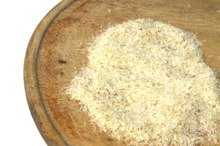What does fact checked mean?
At Healthfully, we strive to deliver objective content that is accurate and up-to-date. Our team periodically reviews articles in order to ensure content quality. The sources cited below consist of evidence from peer-reviewed journals, prominent medical organizations, academic associations, and government data.
The information contained on this site is for informational purposes only, and should not be used as a substitute for the advice of a professional health care provider. Please check with the appropriate physician regarding health questions and concerns. Although we strive to deliver accurate and up-to-date information, no guarantee to that effect is made.
What Is an Amaranth Allergy?
Amaranth is a grain used to make flour for baking. It is often added to wheat flours to make prepackaged breads, crackers and cookies, according to the Thomas Jefferson Agricultural Institute 1. An amaranth allergy will cause adverse reactions within a few minutes or up to an hour after you eat the grain. If you suspect you’re allergic to amaranth, call your doctor for further evaluation. Amaranth allergy is uncommon but does happen. If you’ve been diagnosed with a grain allergy, you may be more prone to an amaranth allergy.
If you are experiencing serious medical symptoms, seek emergency treatment immediately.
Allergy Cause
The allergic reaction is caused by the immune system mistaking the proteins in amaranth for a dangerous substance. The body reacts as if it is under attack and begins to defend itself with antibodies. IgE antibodies are created to specifically fight off the proteins from the grain. Accelerated amounts of histamine cause inflammation in soft tissue, a symptom of most food allergies.
- The allergic reaction is caused by the immune system mistaking the proteins in amaranth for a dangerous substance.
Symptoms
Oatmeal & Headaches
Learn More
Symptoms can range from mild to severe, and affect everyone differently. The increased histamine in the body can cause sinus congestion, asthma, skin reactions and gastric symptoms, according to the Mayo Clinic. Sinus congestion may be accompanied by sneezing, facial pressure and a runny nose. Asthma symptoms from an amaranth allergy include wheezing, coughing, shortness of breath, chest tightness and difficulty breathing. You may develop hives, eczema or general skin irritation from a food allergy 2. Gastric symptoms include:
- nausea
- vomiting
- diarrhea
- stomach pain
- cramping
- bloating
- Symptoms can range from mild to severe, and affect everyone differently.
- Asthma symptoms from an amaranth allergy include wheezing, coughing, shortness of breath, chest tightness and difficulty breathing.
Identification
If your doctor may recommend allergy tests to confirm an amaranth allergy. Allergy tests use two basic approaches, according to the American Academy of Allergy, Asthma and Immunology. Blood tests and skin prick tests are used to see if your body creates IgE antibodies after exposure to the proteins found in amaranth. Skin prick tests inject a small amount of the protein under the skin to see if it becomes inflamed. Blood tests use a sample of your blood to determine if IgE antibodies form after the blood is exposed to the protein.
- If your doctor may recommend allergy tests to confirm an amaranth allergy.
- Skin prick tests inject a small amount of the protein under the skin to see if it becomes inflamed.
Warning
Psyllium Husk Allergy
Learn More
A rare, but potentially life-threatening reaction from an amaranth allergy is possible. Symptoms of severe allergy include inability to breathe, a rapid heart rate and mental confusion. If any of these symptoms occur, seek immediate medical treatment.
Related Articles
References
- Thomas Jefferson Agricultural Institute: Amaranth
- MayoClinic.com: Food Allergy
- Amaranth grain, cooked. FoodData Central. U.S. Department of Agriculture. Published April 1, 2019.
- Capriles VD, Coelho KD, Guerra-Matias AC, Arêas JA. Effects of processing methods on amaranth starch digestibility and predicted glycemic index. J Food Sci. 2008;73(7):H160-4. doi:10.1111/j.1750-3841.2008.00869.x
- Caselato-Sousa, Maria. Amaranth grain and its action on blood glucose level. Journal of Diabetes & Metabolism. November 2014.
- National Institutes of Health Office of Dietary Supplements. Dietary supplement fact sheets.
- Alonso-Miravalles L, O'Mahony JA. Composition, protein profile and rheological properties of pseudocereal-based protein-rich ingredients. Foods. 2018;7(5):73. doi:10.3390/foods7050073
- Caselato-Sousa VM, Amaya-Farfán J. State of knowledge on amaranth grain: A comprehensive review. J Food Sci. 2012;77(4):R93-104. doi:10.1111/j.1750-3841.2012.02645.x
- Aune D, Keum N, Giovannucci E, et al. Whole grain consumption and risk of cardiovascular disease, cancer, and all cause and cause specific mortality: Systematic review and dose-response meta-analysis of prospective studies. BMJ. 2016;353:i2716. doi:10.1136/bmj.i2716
- USDA ChooseMyPlate. Make half your grains whole grains. Updated October 2016.
- American Heart Association. Whole grains, refined grains, and dietary fiber. Updated September 20, 2016.
- Daily Nutritional Goals for Age-Sex Groups Based on Dietary Reference Intakes and Dietary Guidelines Recommendations. USDA Dietary Guidelines 2015–2020.
- Maki KC, Palacios OM, Koecher K, et al. The relationship between whole grain intake and body weight: Results of meta-analyses of observational studies and randomized controlled trials. Nutrients. 2019;11(6):1245. doi:10.3390/nu11061245
- Kasera R, Niphadkar PV, Saran A, Mathur C, Singh AB. First case report of anaphylaxis caused by Rajgira seed flour (Amaranthus paniculatus) from India: a clinico-immunologic evaluation. Asian Pac J Allergy Immunol. 2013;31(1):79-83.
- Vaswani R, Garg V, Khim B, Huang Y, Vaswani S. Anaphylactic reaction to amaranth (amaranthus paniculatus). Annals of Allergy, Asthma & Immunology. 2018;121(5):S113–S114. doi:10.1016/j.anai.2018.09.375
- Chaturvedi A, Sarojini G, Nirmala G, Nirmalamma N, Satyanarayana D. Glycemic index of grain amaranth, wheat and rice in NIDDM subjects. Plant Foods Hum Nutr. 1997;50(2):171-8. doi:10.1007/bf02436036
Writer Bio
Diane Marks started her writing career in 2010 and has been in health care administration for more than 30 years. She holds a registered nurse license from Citizens General Hospital School of Nursing, a Bachelor of Arts in health care education from California University of Pennsylvania and a Master of Science in health administration from the University of Pittsburgh.









